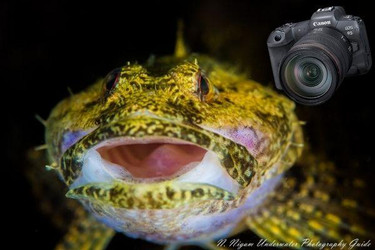Canon EOS R5: A Deep Dive into Underwater Image Quality
October 9th, 2020
Canon EOS R5: A Deep Dive into Underwater Image Quality
With a 45 megapixel CMOS sensor, the Canon EOS R5 is Canon's first professional grade, high-resolution full frame mirrorless camera to hit the market. High resolution is great for underwater photographers whether your goal is large prints or more detail. Macro photographers especially benefit from high resolution cameras as it makes it easy to crop and recompose very small subjects. However, high resolution does cause its share of issues when it comes to image quality including an increase in noise and motion blur. In this article, we take a deeper look at the image quality produced by the Canon EOS R5 and how it affects underwater image quality.
Resolution
Not all resolution is created equally. The quality, sharpness and level of detail in an image does correlated with resolution, but the quality of the sensor is more important. That is why some phones can take high resolution images, but you would never consider using them for professional photography. We cropped the following images to see how good the resolution really is. Overall, we felt that the details from the Canon EOS R5 are beautiful and crisp - certainly enough for professional photography. Macro photographers will be pleased with the results...

Octopus Eye, uncropped

Octopus Eye, 100% crop

Fish, uncropped

Fish, 100% crop
Noise
High resolution sensors tend to be noisier than lower resolution sensors because more pixels are crammed into the same light-sensitive area. It can be harder to shoot at higher ISOs on camera like the Canon EOS R5 because of this. Overall, we found that photos even up to an ISO of 800 were sufficient. Even though there is a little noise at lower resolution - it is very fine grained and easy to remove in post processing. As long as you shoot RAW, you will not have to worry about noise in low light with the EOS R5.

This image was shot with the EOS R5's native ISO of 100 and not corrected for noise. As you can see, there is very little.
Dynamic Range
Dynamic range is the ratio between the highest and lowest measurable light intensities in an image. In other words, it measures how much exposure detail can be captured in an image. Canon cameras are historically notorious for producing limited dynamic range. However, we found the EOS R5 to produce images on par with the Nikon Z7 and Sony A7R IV. Just take a look at the details in the overexposed areas of the sunball photo below. Dynamic range can be especially important for video in scenes with a lot of contrast. Underwater video shooters will be pleased to hear that there are initial reports that the dynamic range has improved on the EOS R5 and could be comparable to the Sony A7S III.

An urchin under the sun captured with the Canon EOS R5 in an Ikelite EOS R5 housing, Canon 8-15mm fisheye lens, dual Ikelite DS 161 strobes, and Ikelite Canon TTL converter. f/22, 1/160, ISO 100
Motion Blur (or the Lack Thereof)
Our favorite feature on Canon EOS R5 is Canon's new 5 axis in-body image-stabilization (IBIS) system. This system stabilizes an image and reduces motion blur at low shutter speeds by moving the camera sensor to correspond with camera shake and motion. Canon's IBIS is capable of 8 stops of exposure recovery, which means that you can shoot at shutter speeds 8 stops lower than you normally could without getting motion blur. We took full advantage of this feature and even shot some of our photos as low as 1/13th of a second. Even at those speeds the images were as crisp as if they had been shot at the camera's sync speed. IBIS also allows you to expand the limits of your camera by allowing you to shoot at lower shutter speeds instead of having to raise your ISO. The added detail and peace of mind that there will be no motion blur makes Canon's IBIS system one of its top features.

A perfect example of the amazing 5 axis IBIS in the Canon EOS R5. 1/13s, f/22, ISO 200. Ikelite EOS R5 housing, Canon 8-15mm fisheye lens, dual Ikelite DS 161 strobes, and Ikelite Canon TTL converter.
Learn more here:
https://www.bluewaterphotostore.com/
Contact our sales department:
Phone: 310-633-5052




